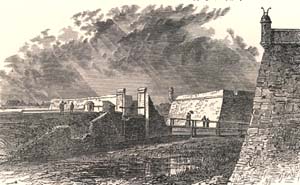The Calvin Shedd Papers > Background > Fort Marion
Fort Marion
| Date(s) of Letter(s) | Fretwell,
Jacqueline, Ed. Civil War Times in St. Augustine. St. Augustine, Florida: St.
Augustine Historical Society, 1986. Little, Henry F. W.The Seventh Regiment New
Hampshire Volunteers in the War of the Rebellion. Concord, New Hampshire: The Seventh
New Hampshire Veteran Association, 1896.
|
| October 12, 1862 February 8, 1863 Coquina Stone |
"Old Fort
Marion, at the northern extremity of the city is worthy of more than a passing
mention....It was a noble fortification, requiring one hundred cannon and one thousand men
as its complement and garrison. It was built in the form of a trapezium, with walls
twenty-one feet high, and enormously thick, with bastions at each corner....Thousands of
hands must have been employed for over half a century in transporting those blocks of
coquina across the bay, and raising them to position in its massive walls. It has
never been taken by a besieging enemy. At either corner were quaint little Moorish
turrets or towers, and across the draw-bridge, just outside the main entrance, was a
formidable little fortification for the protection of the bridge and gateway. Since
the United States Government has come into possession it has further strengthened the
place by construction a water battery....Since the occupation of the place by Union troops
the fort has been put in proper trim, and several heavy guns were in position, mounted en
barbette, a few howitzers, and a few light field-pieces were also in position, ready for
any emergency." (Little, pp. 75-77) The Castillo de San Marcos was constructed by the
Spanish between 1672 and 1695. Florida became British in 1763, and the Castillo was
renamed Fort St. Marks and was protected by the English during the American
Revolution. The fort reverted to Spain in 1784 and remained so until 1821, when the
Spanish transferred Florida to the United States. "The War Department received
custody of the fortification and soon renamed it Fort Marion, because Castillo de San
Marcos was apt to be confused with Fort San Marcos in West Florida. The new name
honored Francis Marion, South Carolina's guerilla leader in the Revolutionary
War." Fort Marion was designated a National Monument in 1924 and its custody
transferred to the Parks Department in 1933. An act of Congress in 1942 restored the
original Spanish name. (Fretwell, p. 47-62). |

